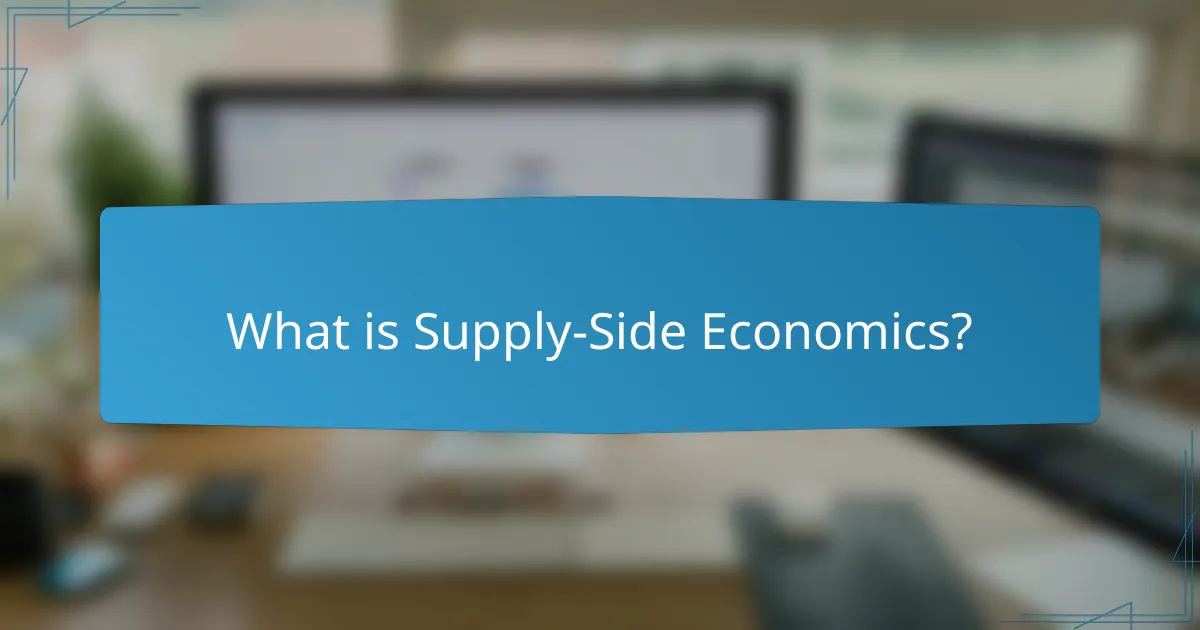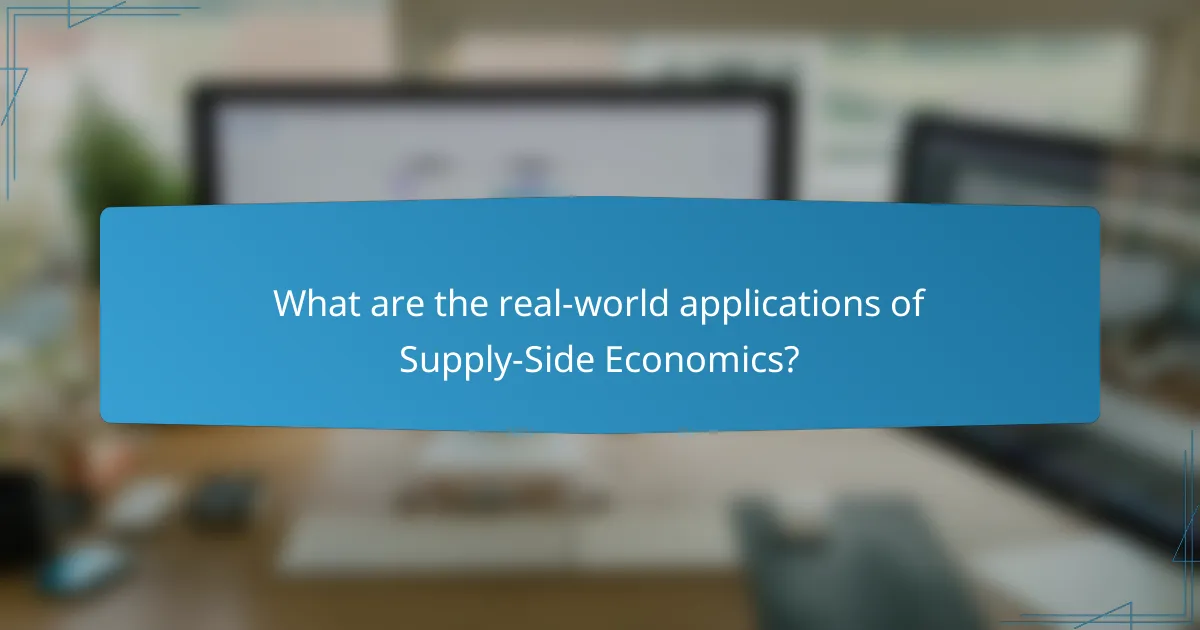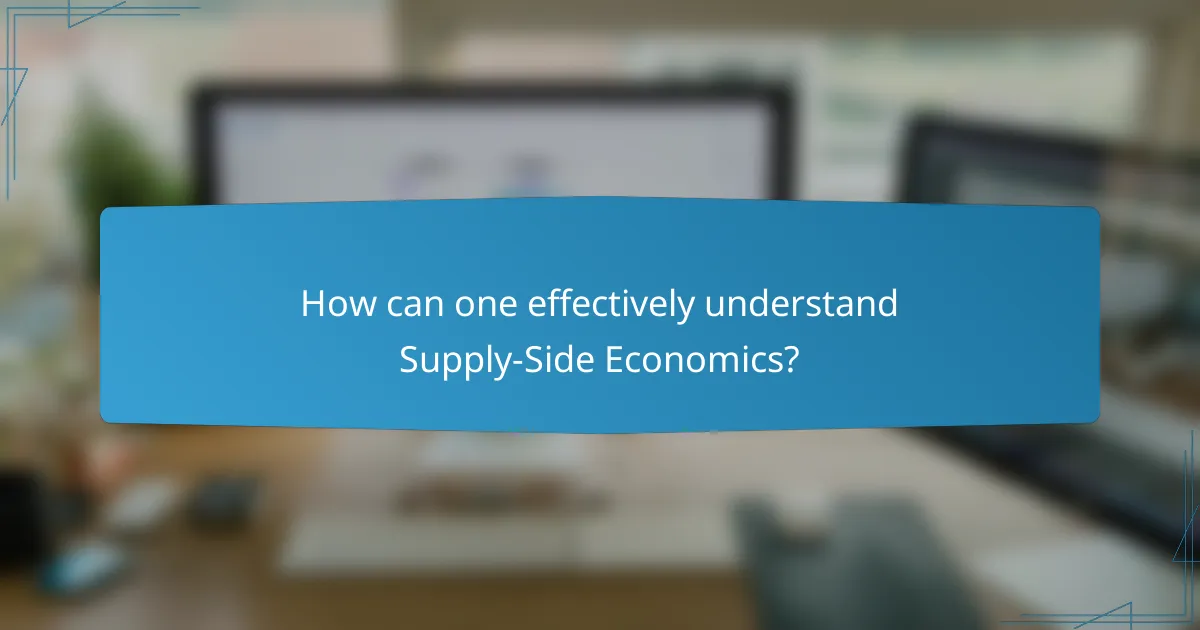Supply-side economics is an economic theory that focuses on enhancing economic growth by increasing the supply of goods and services through lower taxes and reduced regulation. This approach is believed to stimulate job creation and investment, and it gained significant attention during the Reagan administration in the 1980s, particularly with the Economic Recovery Tax Act of 1981. The article explores the core principles of supply-side economics, including its applications in tax policy, deregulation, and fiscal strategies, while also addressing the ongoing debates regarding its impact on income inequality and economic disparities. Historical examples and evidence of its effectiveness, alongside criticisms, provide a comprehensive understanding of this economic theory and its implications in real-world contexts.

What is Supply-Side Economics?
Supply-side economics is an economic theory that emphasizes boosting economic growth by increasing the supply of goods and services. It advocates for lower taxes and reduced regulation to incentivize production. Proponents believe that these measures lead to job creation and increased investment. This theory gained prominence during the Reagan administration in the 1980s. Evidence suggests that tax cuts can stimulate economic activity. For instance, the Economic Recovery Tax Act of 1981 led to significant economic growth. Critics argue that supply-side economics disproportionately benefits the wealthy. However, supporters maintain that a thriving economy ultimately benefits all income levels.
How does Supply-Side Economics differ from other economic theories?
Supply-Side Economics focuses on boosting economic growth by increasing the supply of goods and services. This approach differs from demand-side theories, which prioritize consumer demand as the main driver of economic growth. Supply-Side Economics emphasizes tax cuts and deregulation to incentivize production and investment. In contrast, demand-side theories advocate for government spending to stimulate demand. Historical evidence shows that Supply-Side policies, implemented during the Reagan administration, led to significant economic growth in the 1980s. This growth was characterized by increased employment and GDP. Supply-Side Economics also argues that lower taxes can lead to higher government revenue through increased economic activity. This contrasts with traditional Keynesian views that focus on short-term demand stimulation.
What are the foundational principles of Supply-Side Economics?
Supply-Side Economics is based on the belief that economic growth can be most effectively fostered by lowering taxes and decreasing regulation. This approach emphasizes that reduced tax rates increase incentives for individuals and businesses to work, save, and invest. Consequently, increased investment leads to higher productivity and job creation.
One foundational principle is that lower taxes enhance disposable income, stimulating consumer spending. Another principle is that tax cuts for businesses encourage reinvestment in capital and labor. This can lead to a more robust economic environment.
Historical applications of Supply-Side Economics include the Reagan administration’s tax cuts in the 1980s. These policies aimed to spur economic growth, resulting in a significant increase in GDP during that period.
Research by economists such as Arthur Laffer supports the idea that lower tax rates can lead to increased tax revenues when economic growth occurs.
Why is the focus on production and supply significant?
The focus on production and supply is significant because it drives economic growth. Increased production leads to higher output, which boosts GDP. Supply influences market prices and availability of goods. Efficient supply chains reduce costs for consumers and businesses. A strong focus on these areas can create jobs and improve living standards. Historical data shows that economies prioritizing production see faster recovery during downturns. For example, the post-2008 financial crisis recovery was driven by supply-side policies promoting production. Thus, emphasizing production and supply is crucial for sustainable economic development.
What are the key features of Supply-Side Economics?
Supply-side economics emphasizes tax cuts and deregulation to stimulate economic growth. Key features include reducing income tax rates to incentivize work and investment. It advocates for lowering corporate taxes to encourage business expansion. Supply-side economics promotes deregulation to enhance market efficiency. It suggests that increased production leads to job creation and higher wages. The theory posits that economic growth benefits all income levels through a trickle-down effect. Historical implementations, such as the Reagan administration’s policies, aimed to demonstrate these principles. Evidence shows that lower taxes can lead to increased investment and economic activity.
How do tax cuts influence economic growth in Supply-Side Economics?
Tax cuts influence economic growth in Supply-Side Economics by increasing disposable income for individuals and businesses. This increase in disposable income encourages consumer spending and investment. Higher consumer spending stimulates demand for goods and services. Increased demand can lead to higher production levels. Businesses may respond by expanding operations and hiring more employees. This expansion contributes to overall economic growth. Historical evidence shows that tax cuts, such as those implemented during the Reagan administration, were associated with significant GDP growth. Additionally, the Congressional Budget Office reported that tax reductions can lead to job creation and increased economic activity.
What role does deregulation play in Supply-Side Economics?
Deregulation plays a crucial role in Supply-Side Economics by removing government restrictions on businesses. This approach aims to stimulate economic growth by encouraging investment and production. Deregulation reduces compliance costs for companies, allowing them to allocate resources more efficiently. As a result, businesses can lower prices and increase output. Historical examples include the deregulation of the airline and telecommunications industries in the 1980s. These actions led to increased competition and innovation. Consequently, consumer prices fell, and service quality improved. Overall, deregulation is seen as a means to enhance economic efficiency and productivity within Supply-Side Economics.
What are the potential benefits of Supply-Side Economics?
Supply-side economics can lead to increased economic growth. This approach emphasizes tax cuts and deregulation. Lower tax rates can incentivize businesses to invest more. Increased investment often results in job creation. Job creation can reduce unemployment rates. A larger workforce can boost overall productivity. Enhanced productivity can lead to higher wages for workers. Historical examples, such as the Reagan administration in the 1980s, demonstrate these effects. During that period, GDP growth averaged about 4.5% annually.
How can Supply-Side Economics lead to job creation?
Supply-side economics can lead to job creation by incentivizing investment and production. By reducing taxes on businesses and individuals, supply-side policies increase disposable income. This encourages spending and investment in new ventures. When businesses have more capital, they can expand operations and hire more employees. Historical evidence shows that tax cuts in the 1980s, for example, led to significant job growth. According to the U.S. Bureau of Labor Statistics, employment rose by over 20 million jobs during that decade. Additionally, deregulation can lower operational costs, allowing companies to allocate more resources to hiring.
What impact does Supply-Side Economics have on innovation?
Supply-Side Economics positively impacts innovation by incentivizing investment in research and development. Lower taxes on businesses increase their capital for innovation projects. This leads to higher levels of technological advancement and productivity. Historical examples include the Reagan administration’s tax cuts in the 1980s, which spurred growth in the tech sector. Increased funding for startups and new technologies often results from these economic policies. Consequently, Supply-Side Economics fosters an environment conducive to innovation.

What are the real-world applications of Supply-Side Economics?
Supply-side economics applies in various real-world contexts. One application is tax policy. Lowering income tax rates can incentivize investment and increase consumer spending. Another application is deregulation. Reducing government regulations can enhance business growth and innovation. Supply-side economics is also evident in fiscal policies. Governments may increase spending on infrastructure to stimulate economic activity. Historical examples include the Reagan administration in the 1980s. Tax cuts during this period aimed to boost economic growth. The resulting expansion led to increased GDP and job creation. These applications demonstrate supply-side economics in practice.
How has Supply-Side Economics been implemented in various countries?
Supply-side economics has been implemented in various countries primarily through tax cuts and deregulation. In the United States during the 1980s, President Ronald Reagan’s administration reduced income tax rates significantly. The top income tax rate was lowered from 70% to 28%. This aimed to stimulate investment and economic growth.
In the United Kingdom, Prime Minister Margaret Thatcher adopted similar policies in the 1980s. Her government reduced taxes and privatized state-owned industries. This approach led to increased economic activity and a reduction in inflation.
Countries like Canada also embraced supply-side principles in the 1990s. The Canadian government implemented tax cuts and reduced public spending. This resulted in a balanced budget and economic growth.
In recent years, countries such as India have adopted supply-side measures. The Indian government reduced corporate tax rates to attract foreign investment. This has encouraged business expansion and job creation.
Overall, the implementation of supply-side economics has varied across nations but consistently focuses on tax reductions and deregulation to promote economic growth.
What are some notable examples of Supply-Side policies in action?
Notable examples of Supply-Side policies include the Reagan tax cuts of the 1980s. These cuts aimed to stimulate economic growth by reducing income tax rates for individuals and businesses. The Economic Recovery Tax Act of 1981 lowered the top marginal tax rate from 70% to 50%. This policy was designed to incentivize investment and increase production. Another example is the 2017 Tax Cuts and Jobs Act in the United States. This legislation reduced the corporate tax rate from 35% to 21%. It aimed to encourage businesses to invest and expand. Both instances illustrate how Supply-Side policies focus on boosting economic activity through tax reductions.
How did Supply-Side Economics influence U.S. economic policy in the 1980s?
Supply-side economics significantly influenced U.S. economic policy in the 1980s by promoting tax cuts and deregulation. The Reagan administration implemented substantial tax reductions aimed at stimulating investment. These tax cuts were designed to increase disposable income for individuals and businesses. The theory posited that lower taxes would lead to higher consumer spending and job creation.
In 1981, the Economic Recovery Tax Act was enacted, which reduced individual income tax rates by 25% over three years. This policy was intended to incentivize work and investment. Deregulation in various industries, including energy and telecommunications, aimed to enhance economic efficiency.
The results included a period of economic growth, with GDP growth averaging about 4.5% annually during the mid-1980s. However, critics argue that these policies also contributed to income inequality and increased national debt. The influence of supply-side economics thus shaped both immediate fiscal policies and long-term economic debates in the U.S.
What criticisms exist regarding Supply-Side Economics?
Criticisms of Supply-Side Economics include its reliance on tax cuts to stimulate growth. Critics argue that these tax cuts disproportionately benefit the wealthy. This can lead to increased income inequality. Additionally, opponents claim that the promised economic growth often fails to materialize. Historical examples, such as the tax cuts during the Reagan administration, show mixed results. The theory assumes that benefits will “trickle down” to all income levels, which many economists dispute. Critics also point to rising deficits as a consequence of reduced tax revenues. Overall, the effectiveness of Supply-Side Economics remains a contentious issue among economists.
What are the main arguments against the effectiveness of Supply-Side Economics?
Supply-side economics is often criticized for its ineffectiveness in stimulating economic growth. Critics argue that tax cuts for the wealthy do not necessarily lead to increased investment or job creation. Historical evidence, such as the economic performance during the Reagan administration, shows mixed results. The promised trickle-down effects often fail to materialize, leading to income inequality. Additionally, supply-side policies can increase budget deficits without delivering the expected growth. Empirical studies indicate that demand-side factors play a more significant role in driving economic activity. Overall, these arguments highlight the limitations of supply-side economics in achieving its intended outcomes.
How do critics view the impact of tax cuts on income inequality?
Critics argue that tax cuts exacerbate income inequality. They believe that tax reductions primarily benefit the wealthy. This perspective is supported by data showing that income growth has been disproportionately higher for top earners following tax cuts. For example, a study by the Congressional Budget Office indicated that the top 1% of earners saw their income increase significantly compared to middle and lower-income groups after major tax cuts. Critics also point to the reduced tax revenue that limits government spending on social programs. This reduction in social support can widen the gap between rich and poor. Overall, critics contend that tax cuts do not effectively stimulate broad economic growth but rather concentrate wealth.

How can one effectively understand Supply-Side Economics?
To effectively understand Supply-Side Economics, one should focus on its core principles and historical context. Supply-Side Economics emphasizes the role of producers in driving economic growth. It advocates for lower taxes and reduced regulation to incentivize production. Key features include tax cuts for individuals and businesses, which are believed to stimulate investment. Historical examples include the Reagan administration’s economic policies in the 1980s. These policies aimed to boost economic activity by enhancing supply. Evidence of its impact can be seen in GDP growth rates during that period. Understanding the criticisms and debates surrounding Supply-Side Economics is also crucial. Critics argue that benefits disproportionately favor the wealthy, leading to income inequality.
What resources are available for further learning about Supply-Side Economics?
Books such as “Supply-Side Economics: The New Paradigm” by Arthur B. Laffer provide foundational knowledge. Online courses from platforms like Coursera and edX offer structured learning. The Cato Institute publishes articles and papers on supply-side policies. The National Bureau of Economic Research (NBER) has working papers on related economic theories. The Wall Street Journal frequently covers supply-side economic discussions and analyses. Podcasts like “Freakonomics Radio” explore economic concepts, including supply-side economics. Academic journals such as the “Journal of Economic Perspectives” feature peer-reviewed articles on the topic. These resources collectively enhance understanding of supply-side economics.
What strategies can help in analyzing Supply-Side policies critically?
To analyze supply-side policies critically, one effective strategy is to evaluate their impact on economic growth. This involves examining historical data on GDP growth rates following the implementation of these policies. Another strategy is to assess the effects on income distribution. Analyzing whether wealth concentration has increased or decreased post-implementation is crucial.
Additionally, comparing supply-side policies with demand-side alternatives can provide insights into their effectiveness. This includes looking at case studies from different countries that have adopted various approaches.
Engaging in stakeholder analysis is also vital. Understanding how different groups, such as businesses and consumers, respond to supply-side measures can highlight strengths and weaknesses.
Finally, reviewing academic literature on supply-side economics can offer a broader context. Research such as “The Impact of Supply-Side Policies on Economic Growth” by economists like Arthur Laffer can provide empirical evidence supporting or contesting the effectiveness of these policies.
How can understanding Supply-Side Economics inform personal financial decisions?
Understanding Supply-Side Economics can guide personal financial decisions by emphasizing the importance of tax policies and incentives. Supply-Side Economics posits that lower taxes and reduced regulation stimulate economic growth. Individuals can leverage this understanding to optimize their tax strategies. For example, they might invest in tax-advantaged accounts, such as IRAs or 401(k)s, to benefit from tax deferral. Additionally, recognizing that businesses respond to tax incentives can inform decisions about job sectors to pursue. When supply-side policies are in effect, industries may expand, leading to job creation. Awareness of these trends can help individuals align their career choices with sectors poised for growth. Ultimately, informed financial decisions can lead to enhanced personal wealth and stability.
Supply-side economics is an economic theory that emphasizes enhancing economic growth by increasing the supply of goods and services through lower taxes and reduced regulation. The article covers the foundational principles of supply-side economics, including its key features, such as tax cuts and deregulation, and their impact on job creation, innovation, and overall economic growth. It also contrasts supply-side economics with demand-side theories and discusses historical implementations, notably during the Reagan administration, as well as criticisms regarding income inequality and effectiveness. Real-world applications and examples of supply-side policies in various countries are also examined, providing a comprehensive understanding of this economic approach.